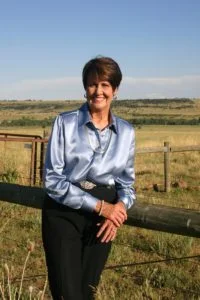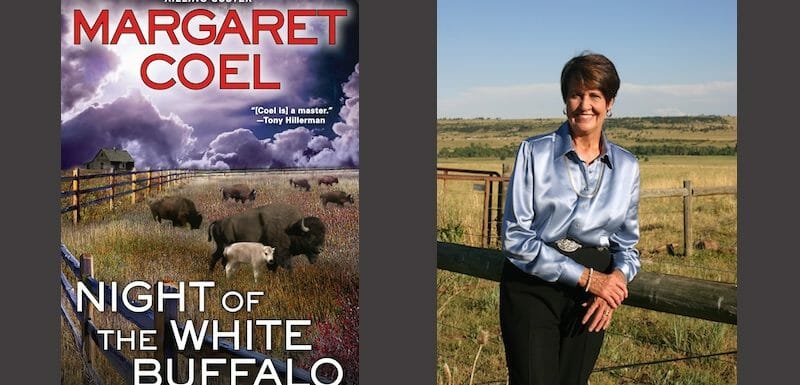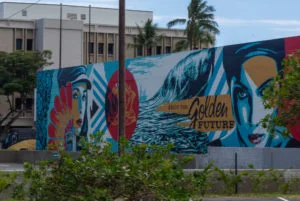 New York Times Bestselling author Margaret Coel has written eighteen Wind River Mysteries. The series features Father John O’Malley and Vicky Holden, two characters who have what could easily be called a complicated relationship. For this interview, Coel discussed her love of history and how she works that into the stories as well as how she personally has been affected by writing the series.
New York Times Bestselling author Margaret Coel has written eighteen Wind River Mysteries. The series features Father John O’Malley and Vicky Holden, two characters who have what could easily be called a complicated relationship. For this interview, Coel discussed her love of history and how she works that into the stories as well as how she personally has been affected by writing the series.
“I started writing nonfiction first,” Coel said. “I got very interested in the history of the West, and specifically of the Rocky Mountain West. And so the first books were really pretty serious studies of different aspects of our history and one of them is called ‘Chief Left Hand.’ That book is a biography of one of the great Arapaho chiefs in the mid 1800s. It’s also a history of the Arapaho people when they lived on the plains. I spent five years researching and writing that book.”
Coel made her first trips to the Wind River Reservation during the writing of “Chief Left Hand.” In addition to allowing her to meet the Arapahos, something else happened. Coel said, “That book really gave me the background out of which I could write the novels that I write. So it gave me a pretty thorough understanding of who these people were, how they lived, where they lived, and all that had happened to them before they were sent to the reservation. Because I love history, I like to weave a lot of that into my novels.”
A fourth-generation Coloradan who grew up in an area filled with stories of what the West had once been like, Coel feels her interest in history is natural. Coel said, “My people came here just after the Arapaho people were forced out of here. The Arapahos were forced out with the Sand Creek Massacre, which occurred in 1864. That really sparked my interest in knowing more about the history of this area and specifically the history of the Plains Indians and even more specifically the history of the Arapaho people.”
In fact, the Arapahos lived in what we know today as Denver and also in Boulder. “I live in Boulder and grew up in Denver,” Coel said. “I always felt like, from early on, that I was walking on land in places where they had once been. Where they had lived. Where they had camped and so I wanted to know more about them. My interest dates back to when I was a child learning about these things.”
 Although many writers like to write about specific themes, Coel said she’s never done that. “I just try to come up with the best story I can come up with and try to tell the story and then there are different things that present themselves as the story is unfolding. So, it’s like the themes come later. I’m always sort of surprised at what the themes are that emerge.
Although many writers like to write about specific themes, Coel said she’s never done that. “I just try to come up with the best story I can come up with and try to tell the story and then there are different things that present themselves as the story is unfolding. So, it’s like the themes come later. I’m always sort of surprised at what the themes are that emerge.
“For ‘The Night of the White Buffalo,’ I was very interested in writing about the sacredness of this incredible creature, a white buffalo, that is so rare when it’s born and is so much a part of the Plains Indian’s mythology. They believe it is really a promise that the Creator made to them that he would always be with them and would send a white buffalo from time-to-time to assure them that they weren’t alone and that whatever was happening in their lives, the Creator was still with them.”
Coel sees the sacredness of the white buffalo as a manifestation of a social custom that exists in many cultures. She said, “I think in our culture we tend to not recognize signs, but in the Indian culture and the Plains Indian culture they’re very alert to signs. I think all of that plays into the story of ‘The Night of the White Buffalo.’ But, it is a mystery novel and certainly I wanted it to be a good mystery one that would keep you reading and keep you wondering what the heck was going on here!”
The fact that Coel must write convincingly about the Arapaho customs and beliefs raises the question of whether she has come to believe in signs. “Absolutely. Oh, absolutely,” she said. “There’s no question that this has changed my whole life. I am very open to signs.”
Another sign from the Arapaho culture Coel mentioned is the appearance of an eagle. “When I see an eagle overhead I stop, it absolutely stops me cold and I just look at it because in the Arapaho culture, they say that whenever an eagle comes it’s a blessing from the Creator. The eagle flies the highest and is the creature that goes to the Creator and brings messages back. So, every time I see an eagle, which I do see frequently, it’s amazing. I always think of it like it’s kind of a miracle.”
It’s those types of small miracles that have led Coel to writing the Wind River Mysteries. The path, however, was not direct. Coel said, “I’ve always followed the advice I got from a writing teacher many years ago, which was write what you read. I read history. I love history. I read biography. And so, I wrote biography and I wrote four history books. And then I thought that I’d like to write fiction and I asked myself what type of fiction I liked to read. I really like to read mysteries!
“I like the fact that in a mystery novel you have a strong story. There’s something going on. Always something happening. So, you don’t just have a lot of characters sitting around and thinking or studying their navels. You have people who are really engaged in the world. They’re engaged in what’s going on. And what is going on matters. It’s a matter of life and death and so that’s what drew me to the mystery genre. I thought well, I like them, I enjoy them, and I’d like to try to tell one.”
As a fledgling mystery writer, Coel attended a conference at which award-winning author Tony Hillerman was speaking. “I had read Tony Hillerman,” said Coel. “I loved his books and remember sitting there in this huge ballroom and listening to him talk. He talked about how much writing about the Navajos had changed and enriched his life. I sat there thinking, ‘I could do that. I could write about the Arapahos.’ I told him that story. He laughed and said, ‘I had no idea I had inspired you that way.’”
In most of Coel’s novels, she blends real events and fiction. In speaking of ‘Blood Memory, the first Catherine McLeod novel set in Denver, she said, “I was able to work in the actual efforts of some casino operators to try to reclaim Cheyenne and Arapaho land around Denver. Specifically, they wanted land near the Denver International Airport in order to put up a huge destination-type casino and hotel. That actually did go on and that involved the Arapaho tribe and the Cheyennes’s, who were also here. It came to nothing, but it was a very interesting interlude.”
Coel writes about historical events differently than other writers might. “What I try to do is to show what is going on from the way the Arapahos look at it. What it means to them. How it affects them. What has come out of their history. All that type of thing. I always try to add more to it than just the surface newspaper story.”
Coel admitted that she does extensive research to make sure each book is consistent with those she has written previously. “It’s kind of difficult to keep it all straight, especially with so many books. I try not to veer too far afield and, when I do, my readers bring me right back. They tell me what kind of car Vicky was driving in the last book and they want to know why she’s driving a different kind of car. When did she get a new car?”
In addition to making sure her writing is consistent throughout her series, Coel is also a stickler for historical details. “I bring a lot of history into my books,” she said. “I am a historian and I am very, very adamant about having accurate history, even in fiction. For any history that I write, I do a lot of research and I check and double-check the facts.”
There are, however, times when the historical events need a little tweaking to make a story work. For those cases, Coel said, “ Sometimes I have to change the history a little bit for the story, but if I ever do that, I put an author’s note in the back. This is what actually happened. I made it happen at a different time or whatever to meet the requirements of my story. But, I separate it out for the reader so that the reader knows exactly what happened and what I’ve made up.”
In the reading she does, Coel sometimes sees authors who change history without letting readers know what they’ve done. Coel said, “That makes me crazy. I picked up a book not long ago, it was a novel, but it dealt with real issues that had happened and they got it all wrong. I think we have a responsibility to be true to the past and to not reinterpret all the time just the way that we wish it might have happened, but to try and be objective and to say this is what we know happened.”
So that she could bring in a good deal of history, Coel made her male protagonist, Father John, a historian also. “I made him a historian so that he could deal with some of these issues because he has an understanding of the past and he has that understanding of how the past still influences the present and I like that about his character. I can work my own concerns through his character, because he and I have the same concerns about that.”
Fans of the Wind River Mystery series will be pleased to know that Coel still finds each day with her characters to be exciting. “I’m just about to finish the 19th Wind River story and my characters are still surprising me and I’m still interested in them. I go to my computer every morning and my first thought is, ‘Well, what are you doing today? What’s going on now?’ I’m still very involved with them.”
Coel also said that she’ll know when the time is right to stop writing the series. “If a time comes where I feel that Vicky and Father John are no longer interesting to me, that I’m no longer surprised by them, if it ever becomes ‘ho-hum’ doing the same old thing, that’s the day I’ll quit. So far, that has not happened. Nothing lasts forever and I don’t expect that feeling I have to last forever so when it stops, I’ll stop.”
For now, however, that end appears to be many books away. “Because of where the Arapahos were located on the Central Plains and the Rocky Mountain Region, they were involved in many things that happened in history. They were part of it and that has given me a wealth of information to write about. There are so many stories that every time I think I’m done telling them, another one will pop into my head.”
The next Wind River Mystery came about exactly because of something Coel recently read about Arapaho history. She said, “The story I’m writing right now deals with Butch Cassidy. Who knew that Butch Cassidy and the Sundance Kid, after their train robberies, would hide out on the Wind River Reservation? They were friends with the Arapaho people. I started reading about that and that gave me a great idea for a story. The Arapaho’s have been involved with so many people and events in history that its a very rich lode for me to mine.”
Coel is very satisfied with her career of writing fiction, but there is one thing she wishes she’d done differently. She said, “My only regret is that I didn’t start down that path a lot sooner.”
More information
Learn more about Margaret Coel on her website at www.margaretcoel.com.


My book club is reading THE GIRL WITH BRAIDED HAIR this fall. How can I
surprise them? Donna Collins, Sedona, Az
HI Donna, I’m not quite sure what you mean. If you’re looking for something from Margaret, you might try going to her website and getting the contact email address. I don’t believe she’s monitoring this interview any longer since it’s quite old now.
How interesting. Didn’t know of this series—now on my to-read list!